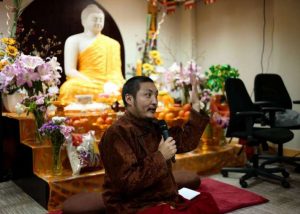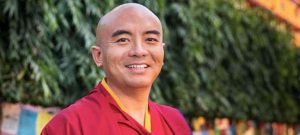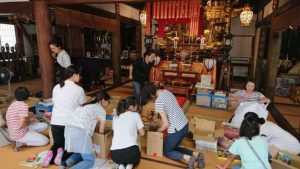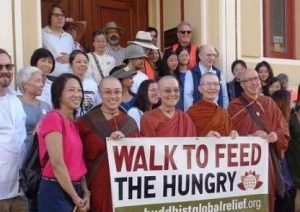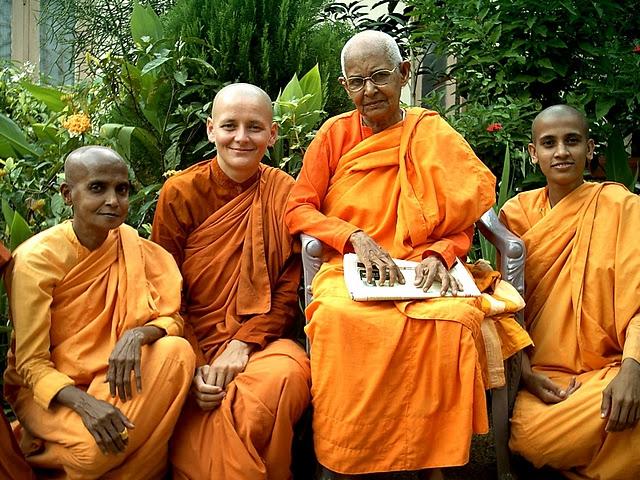
Editor’s note: This feature was first published in the now-retired Bodhi Journal, Issue 1, October 2006.
After a hiatus of one thousand years, Theravadin women once more have the opportunity to be ordained as bhikkhunis and thus become full members of the sangha. Traditionally the sangha is composed of fully ordained nuns (bhikkuni), fully ordained monks (bhikkhu), novice nuns (samaneri), and novice monks (samanera).
From the 3rd century BC when King Ashoka’s son, Mahinda, and daughter Sanghamitta, brought the ordination lineages of both monks and nuns from India to Sri Lanka, there was a long, proud history of male and female monasticism on this island.
In the 11th century, as a result of war, drought and famine, both the monks’ and nuns’ orders died out in Sri Lanka. The bhikkhu order was revived within one generation by inviting a group of bhikkhus from Siam (Thailand) who fulfilled the requirements for giving bhikkhu ordination. However, as the Bhikkuni Order did not exist in any other Theravada country, the requirement that a bhikkuni receive her ordination from a group of ten bhikkhunis of ten years standing followed by a further ceremony presided over by monks could not be met. Thus the bhikkhuni lineage lapsed.
Hence, since the beginning of the 11th century, women wishing to commit themselves to the renunciate life have had only one option: ten lay precepts. Even the ten precepts of a samanera have been denied them, since in the Theravada tradition these can be given only by a bhikkuni. The status of these ten precept nuns, known a dasa sil matas (literally Ten Precept Mothers), is ambiguous; they are considered neither proper monastics nor lay women either.
The situation in the other Theravada countries is even more difficult. It seems that in Thailand and Cambodia there never were bhikkunis, and although they were possibly present in Burma at one time, there too the lineage did not survive. In modern times, Burma has nuns with the ten lay precepts who, like the dasa sil matas in Sri Lanka, are not thought to be true nuns. In Thailand and Cambodia, even the ten lay precepts are denied women, and the nuns there are restricted to eight precepts with a corresponding diminishment of status.
Thus the four-fold community of fully ordained nuns, fully ordained monks, lay women and lay men, which the Buddha clearly declared was integral to the success of the Buddha Dhamma, has been absent from all Theravada countries for one thousand years.
Recently, however, after extensive research by a group of women from Sri Lanka and Europe, it was confirmed that the bhikkuni lineage extant in Taiwan and Korea is actually of Sri Lankan origin and therefore could legitimately be used to ordain Theravada nuns and restore the bhikkuni order.
Although I received novice ordination in the Tibetan tradition in 1993, I decided to visit Sri Lanka to receive the samaneri vows of the Theravada Vinaya school.
Since the first ordination of Sri Lankan bhikkunis in 1996, which was conducted in Sarnath, India by Korean monks and nuns, there have been further ordination ceremonies in Bodh Gaya and in Sri Lanka. There are now over 200 fully ordained nuns as well as many novice nuns who are planning to receive the higher ordination, which they are eligible to do after having kept their samaneri vows for two years.
Behind this amazing resurgence is an organization called Sakyadhita, Daughters of the Buddha, which was established at a conference of Buddhist women held in Bodh Gaya in 1987. Since then there have been six Sakyadhita conferences, including one held in Colombo, Sri Lanka in 1993. At the time of that conference there was strong opposition from the religious authorities of Sri Lanka. However as an outgrowth of that conference, and from the exposure the dasa sil matas have had to fully ordain nuns from other traditions, the aspiration to revive the Theravada bhikkuni lineage was born. With careful negotiations over several years and the eventual support of prominent members of the (male) monastic community, the situation changed completely. Much of the vision and energy for the project has come from Mrs. Ranjani de Silva, who attended the first Sakyadhita conference in Bodh Gaya, has been its President since 1995, and who conceived and organized the 3rd conference in Colombo.
During my visit to Sri Lanka I stayed at the Sakyadhita Training Centre established at Panadura, south of Colombo. At the centre regular programs are organized for the nuns on such topics as community health care, counseling skills and social development.
Nuns come from small nunneries all over the island to attend these training sessions; they seem to be motivated by a strong desire to be of practical benefit in their communities. There are also young nuns attending university where they are studying Pali language, Buddhist philosophy, Buddhist history and other related topics.
In addition to providing the facilities for these training programs, the centre is ‘home’ to seven nuns, and I felt privileged to have the opportunity to spend time with them. Some of them are doing university studies and the older, educated nuns teach. Neighborhood children come for Dhamma classes; local people, often women, come to talk, to receive advice, or to participate in the evening puja.
On three occasions during my brief stay we were invited out to family homes for the daily meal. Two of these were anniversaries of family deaths, and the senior nuns conducted the necessary ceremonies with confidence and dignity. In the past it would have been monks fulfilling these functions, so it is significant that some families are now choosing to invite nuns to officiate instead.
For me, however, it is the third invitation that is the most memorable. It came from a rather poor family living just down the lane near the Sakyadhita Centre. When the Centre was first built and the nuns began living there, the husband, an abusive drunkard who terrorized his family, was deeply hostile to the presence of the nuns. I was told that if he discovered his wife or three daughters had visited the nuns, they were beaten. And there we were, two years later, being offered a meal by the whole family, sober husband included, in their living room. The reverence and delight and the quiet pride were palpable.







